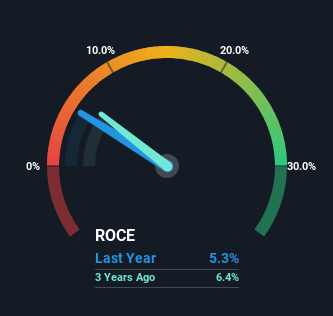Capital Allocation Trends At United Nilgiri Tea Estates (NSE:UNITEDTEA) Aren't Ideal

Finding a business that has the potential to grow substantially is not easy, but it is possible if we look at a few key financial metrics. One common approach is to try and find a company with returns on capital employed (ROCE) that are increasing, in conjunction with a growing amount of capital employed. If you see this, it typically means it's a company with a great business model and plenty of profitable reinvestment opportunities. However, after investigating United Nilgiri Tea Estates (NSE:UNITEDTEA), we don't think it's current trends fit the mold of a multi-bagger.
What Is Return On Capital Employed (ROCE)?
For those who don't know, ROCE is a measure of a company's yearly pre-tax profit (its return), relative to the capital employed in the business. To calculate this metric for United Nilgiri Tea Estates, this is the formula:
Return on Capital Employed = Earnings Before Interest and Tax (EBIT) ÷ (Total Assets - Current Liabilities)
0.053 = ₹101m ÷ (₹2.0b - ₹63m) (Based on the trailing twelve months to March 2023).
So, United Nilgiri Tea Estates has an ROCE of 5.3%. Ultimately, that's a low return and it under-performs the Food industry average of 12%.
See our latest analysis for United Nilgiri Tea Estates

While the past is not representative of the future, it can be helpful to know how a company has performed historically, which is why we have this chart above. If you want to delve into the historical earnings, revenue and cash flow of United Nilgiri Tea Estates, check out these free graphs here.
SWOT Analysis for United Nilgiri Tea Estates
- Earnings growth over the past year exceeded the industry.
- Currently debt free.
- Dividends are covered by earnings and cash flows.
- Dividend is low compared to the top 25% of dividend payers in the Food market.
- Trading below our estimate of fair value by more than 20%.
- Lack of analyst coverage makes it difficult to determine UNITEDTEA's earnings prospects.
- No apparent threats visible for UNITEDTEA.
What The Trend Of ROCE Can Tell Us
In terms of United Nilgiri Tea Estates' historical ROCE movements, the trend isn't fantastic. To be more specific, ROCE has fallen from 8.7% over the last five years. Although, given both revenue and the amount of assets employed in the business have increased, it could suggest the company is investing in growth, and the extra capital has led to a short-term reduction in ROCE. And if the increased capital generates additional returns, the business, and thus shareholders, will benefit in the long run.
Our Take On United Nilgiri Tea Estates' ROCE
Even though returns on capital have fallen in the short term, we find it promising that revenue and capital employed have both increased for United Nilgiri Tea Estates. These growth trends haven't led to growth returns though, since the stock has fallen 14% over the last five years. So we think it'd be worthwhile to look further into this stock given the trends look encouraging.
Since virtually every company faces some risks, it's worth knowing what they are, and we've spotted 2 warning signs for United Nilgiri Tea Estates (of which 1 is significant!) that you should know about.
If you want to search for solid companies with great earnings, check out this free list of companies with good balance sheets and impressive returns on equity.
New: AI Stock Screener & Alerts
Our new AI Stock Screener scans the market every day to uncover opportunities.
• Dividend Powerhouses (3%+ Yield)
• Undervalued Small Caps with Insider Buying
• High growth Tech and AI Companies
Or build your own from over 50 metrics.
Have feedback on this article? Concerned about the content? Get in touch with us directly. Alternatively, email editorial-team (at) simplywallst.com.
This article by Simply Wall St is general in nature. We provide commentary based on historical data and analyst forecasts only using an unbiased methodology and our articles are not intended to be financial advice. It does not constitute a recommendation to buy or sell any stock, and does not take account of your objectives, or your financial situation. We aim to bring you long-term focused analysis driven by fundamental data. Note that our analysis may not factor in the latest price-sensitive company announcements or qualitative material. Simply Wall St has no position in any stocks mentioned.
About NSEI:UNITEDTEA
United Nilgiri Tea Estates
Engages in growing, manufacturing, and selling teas in India.
Flawless balance sheet average dividend payer.
Market Insights
Community Narratives



